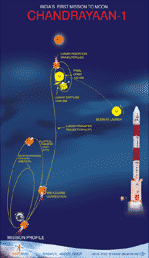High resolution remote sensing of the moon in the visible, near infrared,
low energy X-ray and high-energy X-ray regions for:
Preparing 3-dimensional atlas of regions of scientific interest with a high spatial and altitude resolution of 5-10 m
Chemical mapping of the entire lunar surface for elements such as Mg, Al, Si, Ca, Fe and Ti with a spatial resolution of 10 km and elements of high atomic numbers (Z), such as 222Rn, U, Th and Gd with a spatial resolution of 20 km
Mission Objectives:
To realise the mission goal of harnessing the science payloads, lunar craft and the launch vehicle with suitable ground support systems including DSN station.
To realise the integration and testing, launching and achieving lunar polar orbit of about 100 km, in-orbit operation of experiments, communication/ telecommand, telemetry data reception, quick look data and archival for scientific utilization by identified group of scientists.
Preparing 3-dimensional atlas of regions of scientific interest with a high spatial and altitude resolution of 5-10 m
Chemical mapping of the entire lunar surface for elements such as Mg, Al, Si, Ca, Fe and Ti with a spatial resolution of 10 km and elements of high atomic numbers (Z), such as 222Rn, U, Th and Gd with a spatial resolution of 20 km
Mission Objectives:
To realise the mission goal of harnessing the science payloads, lunar craft and the launch vehicle with suitable ground support systems including DSN station.
To realise the integration and testing, launching and achieving lunar polar orbit of about 100 km, in-orbit operation of experiments, communication/ telecommand, telemetry data reception, quick look data and archival for scientific utilization by identified group of scientists.



